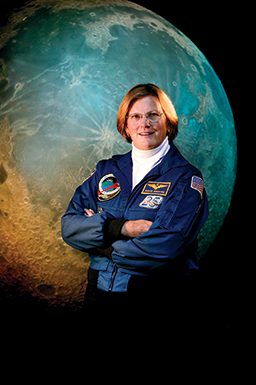Hometown: Paterson, N.J.
Age: 59
Years Diving: 27
Favorite Destination: Palau (“for the spectacular scenery above and below the surface”) and Little Cayman
Why I’m a DAN Member: “I always look for the leading professional and safety society in each field of my endeavors. DAN provides me with a continued flow of information and advice.”

When it comes to applied scientific principles, there is some marginal overlap between astronauts and scuba divers. When it comes to the people who apply them, however, there is more often a dichotomy between those who dream of going to outer space and those who seek to plumb the deepest reaches of the ocean. Few can imagine doing both in a lifetime, but Dr. Kathryn Sullivan’s remarkable career has taken her to both extremes.
Sullivan’s quest for adventure began in academia, with a bachelor’s degree in Earth sciences from the University of California, Santa Cruz, in 1973 and a doctorate in geology from Dalhousie University in Halifax, Nova Scotia, in 1978. During her doctoral studies, she participated in a variety of oceanographic expeditions under the auspices of the U.S. Geological Survey, Woods Hole Oceanographic Institution and the Bedford Institute of Oceanography. Her work on the expeditions set the hook for her appreciation of the ocean, both in terms of science and recreational diving.
In 1977 she was one of 8,500 people who applied to NASA’s astronaut program. The class of ’78 was selected based on academic qualifications, aptitude for challenging tasks and relevant prior experience. Her aquatic research is what Sullivan speculates might have set her apart from the crowd. She contends, “I believe my blue-water oceanographic expedition experience helped me a lot.”
Sullivan achieved a career milestone in 1984 when she became the first woman to walk in space. She participated in three shuttle missions and in 2004 was inducted into the U.S. Astronaut Hall of Fame. It was during her astronaut training that Sullivan learned to scuba dive. She subsequently became a member of Sea Space Symposium, a select group of marine and space professionals that melds technical symposia and diving in each of its biannual meetings
Sullivan’s expertise in science and technology also presented her with opportunities for diving with remotely operated vehicles (ROVs) and submersibles. “I’ve had a few delightful experiences, such as diving to 6,500 fsw in the Pisces II and making an 8,500 fsw dive in the East Pacific Rise off Mexico in Alvin. One of my most memorable deep sea experiences was flying around in a single-seat DeepWorker submersible in the Dry Tortugas.”
When asked about her ongoing involvement in scuba diving as both a recreation and means of oceanic research, Sullivan remarked on the similarities of undersea and outer space explorations. “Both environments present technical and survival challenges and require broadly similar life-support equipment,” she said. “They also necessitate ongoing training and education. Divers and astronauts should never become complacent about where they stand on the learning curve. Regardless of your avocation, I believe that everyone should stay hungry to learn more!”
Today, Sullivan is director of the Battelle Center for Mathematics and Science Education Policy in the John Glenn School of Public Affairs at Ohio State University. Although her career has garnered her enormous success and media attention, Sullivan still relishes every class she teaches and every dive she makes. “I have been very fortunate to have a string of experiences that made headlines. But I don’t need boldface headlines to be astounded. My motto is: Never take your own press releases too seriously!”
Career Highlights
A true pioneer of both inner and outer space, Kathryn Sullivan’s list of accomplishments is as long as the distance she travels to explore. Some of her career highlights include:
- In 1993, left NASA to accept a presidential appointment to the post of chief scientist at the National Oceanic and Atmospheric Administration (NOAA). During her tenure, she oversaw a wide array of research and technology programs ranging from climate and global change to satellites and marine biodiversity.
- Played a pivotal role in creating the Challenger Center for Space Science Education
- From 1996 to 2005, president and chief executive officer of the Center of Science and Industry (COSI) in Columbus, Ohio, one of the nation’s premier centers for hands-on-science learning
- Served as vice chairman of the National Science Board and was a captain in the U.S. Naval Reserve oceanography program
- Recipient of more than two dozen awards and honors, including membership in the U.S. Astronaut Hall of Fame, the 2005 Aviation Week & Space Technology Aerospace Legend Award, the NASA Outstanding Leadership Medal and four presidential nominations under four different U.S. Presidents
- In 2008, inducted into the Women Divers Hall of Fame
- In 2010, inducted into the Women in Aviation International Pioneer Hall of Fame
© Alert Diver — Q4 Fall 2010